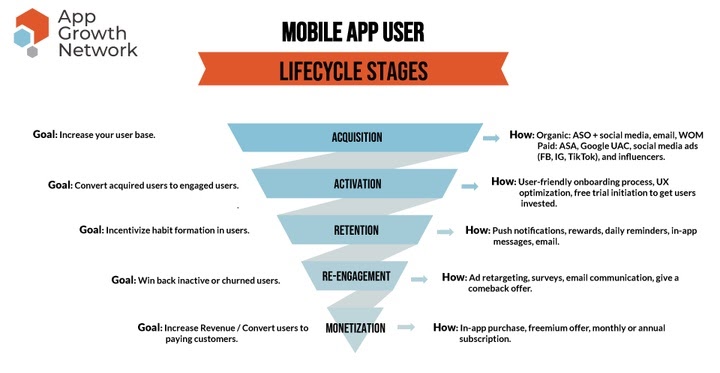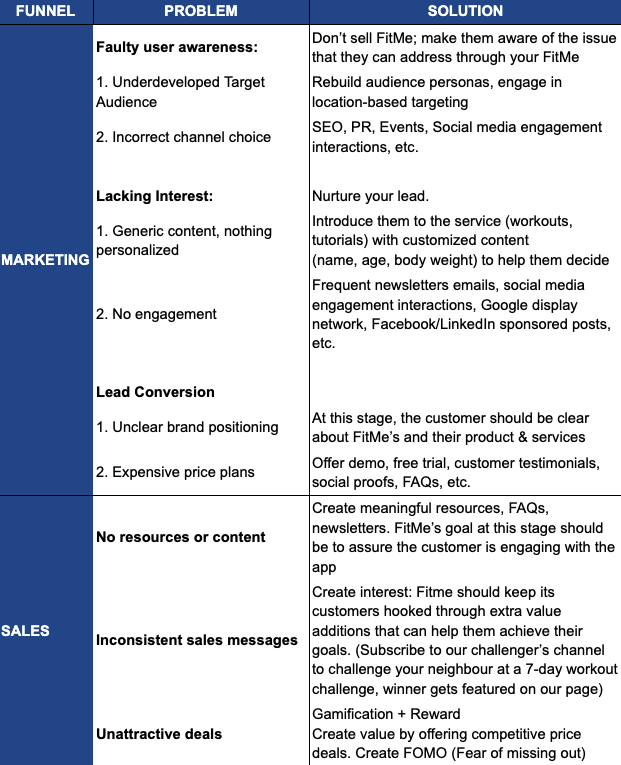How to Optimize the Performance of Health & Fitness Apps Through a Lifecycle Marketing Approach
When developing winning app marketing strategies—whether it’s a health and fitness app or productivity app—there’s simply no one-size-fits-all approach. That’s because every one of the 5+ million apps out there faces its own set of challenges.
For some mobile apps, their main challenge is awareness and attracting app installs. For others, getting downloads isn’t the issue, but retaining users and reducing the churn rate is. And yet, for others, it’s getting users to make an in-app purchase or complete a subscription in order to monetize.
In essence, every app experiences a leak somewhere in the customer lifecycle marketing funnel. Identifying where this is happening (i.e. exactly what the main problem is) is half the battle.
Then comes the other half—identifying why the leak is happening—which in turn dictates the best approach available to fix the problem.
We’ll be referencing the app customer lifecycle marketing funnel quite a bit, so you’ll want to keep this visual in mind!
The best way to illustrate how the funnel leak identification, cause and solution-searching process works is, of course, via an example. We’ll walk you through how seasoned app marketers approach an app’s growth strategy based on the type of app it is, the challenges the app is facing, and what the business objectives are.
So, let’s do that now with a hypothetical health and fitness app called FitMe.
Health & Fitness App Background
App description: FitMe is a health and fitness app that focuses on at-home workouts for busy adults. Workout lengths range from 10 to 20 minutes in a variety of styles including HIIT, Bodyweight Training, Weight Training, and Yoga.
FitMe offers a 7-day free trial with the option to purchase a subscription for $9.99/month or $69.00/year after the free trial period.
Challenge: User retention rates are low. The app gets thousands of downloads per week but the churn rate is high, with significant retention rate drops at Day 1, Day 7 and Day 30.
Reasons Why App Retention Rate is Low
Given the app’s description and its main challenge (retaining users), AGN would investigate app functionality and in-app events focused on the activation, engagement and re-engagement stages of the lifecycle marketing funnel identified above.
Here are some of the reasons that FitMe struggles with low app retention rates:
Subpar Onboarding Process
For FitMe, the onboarding process starts with a registration screen—where the user is asked to create an account using an email address, Google or Facebook account.
Next (if the user decides to complete this step), FitMe takes the user through a 10-screen visual tutorial of all of the app’s features, including the four workout type options, how to select the session length, how to choose the workout narrator voice, plus other details.
After registering and after scrolling through the tutorial, the user can then choose a workout and start a session.
The first thing we do at AGN is ask ourselves (from the user’s perspective): “what do I want to experience now to make me want to use this app?” And, “what is it about this onboarding process that doesn’t make me want to continue until I reach the first workout?
From the current onboarding process experience, here are some reasons that explain the activation stage leak and the cause of low Day 1 app retention rates:
- The app’s USP (unique selling proposition) isn’t validated at first open
The user downloaded FitMe for a reason, and the first thing they should see when they open the app is an affirmation of why they did so.
- Asking for the user to provide personal information too early in the process
In today’s privacy era, people are turned off by technology that asks them to give away personal details—like name and/or email address—especially if they don’t know why or how this information will be used.
The user downloaded FitMe to work out, feel healthier…why do they need to set up an account? If they don’t see the value right away, this could be a major reason why they never get past this screen and become a churned user.
- The visual tutorial is too long and detailed
The reality is that a new user doesn’t need to know everything about FitMe from the get-go. They especially don’t need details about HIIT workouts if 20-minute yoga sessions were the main reason they downloaded the app. Wasting a person’s time is a surefire way to lose them!
The Product is Missing Something the User Values
With market and competitor research, the team determines that a major reason that users install and use fitness apps is the motivation factor and gamification they receive. Most of FitMe’s major competitors include challenges or offer rewards for consistent performance.
FitMe, however, offers no motivational rewards or messaging. There is no communication if a user finishes their first workout or completes a three or 5-day workout streak. A FitMe user, essentially, doesn’t feel supported by the FitMe team or community.
Faulty Sales and Marketing Funnel
How to Increase App Retention Rate and Reduce Churn Rate
Optimize FitMe’s Onboarding Process
- Communicate FitMe’s USP clearly: The solution could involve a welcoming, to-the-point screen of what FitMe is and communicate the unique benefits the app offers the new user.
- Delay the ask for personal information: Instead, FitMe should ask the user-specific questions about what benefit they’re looking for the most—without asking for personal info.
Questions like “what style of workout do you prefer”, “how many times per week do you want to work out”, “how long is your ideal workout session,” and “what is your main health goal?” By going through these questions, the user is not only already vested but they start understanding the why behind the request for information. Only after they’ve received an invitation to “see my plan” should FitMe ask them to create an account.
- Reduce the number of screens required to reach the first action (trying a workout): A person interested in yoga doesn’t need to know about the other styles of workouts…yet. FitMe will retain their users more by giving them exactly what they want when they want it.
The best approach to introducing new app mechanics is showing them at the relevant time and showing them how features work in context—when they get to them.
Onboarding Campaigns: Incentive vs. Non-Incentive
Each person has their own way of interacting with an app, especially when it comes to fitness. Everyone has their own pace, goals and means to achieve them. In order for FitMe to engage such users — along with effective onboarding campaigns that deliver relevant content—they would need to utilize In-app messaging capabilities like those of Leanplum to implement a holistic approach.
There are two types of onboarding campaigns FitMe could consider:
- Incentive campaigns: This means running an incentive-based campaign such as earning extra points or unlocking new workouts/sessions for any completed step. Using a daily challenge that would suit certain types of user behavior would entail a greater number of returning users.
- Non-incentive campaigns: This approach helps increase retention by motivating users through non-incentive means like sharing workouts with friends or sharing music playlists for workouts.
But most importantly it’s important to see what type of campaign is required for which type of users, making segmentation of different audiences and understanding of those segmentations is very important for successful user retention.
Send the Right Messaging at the Right Time (Push Notifications)
In every sense, timing is very important for good things to happen. Thus, sending the right messaging is all about understanding user behavior. As we spoke in the last section about the importance of segmentation and understanding of our audience for retention, it’s equally important to utilize that for effective user engagement.
While most would agree that a lot of notifications can result in weaker engagement, the same can be said about too few notifications. That’s why striking the right balance is so important. Creating time-sensitive campaigns within Leanplum provides a strategic way to engage users at the right time.
Offer Rewards and Gamification Elements
One of the main reasons for user churn with health and fitness apps is the inability to keep users motivated towards chasing health goals.
Applying relevant gamification elements can result in significant user retention. There are a few ways FitMe could apply this strategy:
- showing users their progress to trigger desired behavior
- creating virtual badges and points collections that reward the actions that are linked to your users’ health
- creating personalized challenges to increase your users’ enjoyment
- set up a referral program where users get one-month free by sharing the app or progress with their friends and family
Conduct A/B testing
Oftentimes it’s the lack of experimentation or inability to get feedback from users on product changes that lead to inadequate understanding about our core users A/B testing an upgrade in the product with constant feedback can create a win-win situation for the app client and users.
With the help of Leanplum’s A/B testing tool, one can better understand the factors that enable users to engage with various options while providing feedback on what works best.
For a detailed look at communication strategies that work best at each stage of the health and fitness app customer lifecycle funnel, download our ebook, “How to Make a Health & Fitness App Successful“.
—
To learn more about what Leanplum can do for your team, check out these resources:
- Explore our new Subscription Data Science Report to see where we’ve analyzed billions of subscription app events and message sends to bring you the best strategies and recommendations for growing and monetizing your app
- We are the only engagement platform with a focus on Gaming, Subscription Apps and On-Demand & Mobile Retail
- Check out the Product Tour to see Leanplum in action
- Set up a complimentary personalized demo of Leanplum
—
For app-first companies, Leanplum is the only solution that helps personalize and optimize all customer touchpoints, both inside and outside the app. Leanplum combines multi-channel Lifecycle Marketing with the ability to A/B test the Product Experience for complete, end-to-end personalization of the mobile journey. Break down organizational silos and eliminate point solutions to enable rapid growth.





